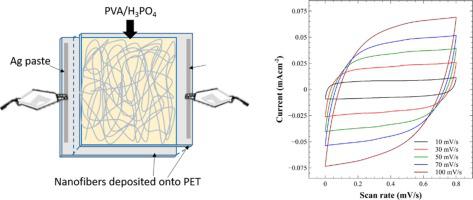当前位置:
X-MOL 学术
›
Synth. Met.
›
论文详情
Our official English website, www.x-mol.net, welcomes your
feedback! (Note: you will need to create a separate account there.)
Flexibleand transparent supercapacitors using electrospun PEDOT:PSS electrodes
Synthetic Metals ( IF 4.0 ) Pub Date : 2020-09-01 , DOI: 10.1016/j.synthmet.2020.116436 J. Cárdenas-Martínez , Beatriz L. España-Sánchez , Rodrigo Esparza , José A. Ávila-Niño
Synthetic Metals ( IF 4.0 ) Pub Date : 2020-09-01 , DOI: 10.1016/j.synthmet.2020.116436 J. Cárdenas-Martínez , Beatriz L. España-Sánchez , Rodrigo Esparza , José A. Ávila-Niño

|
Abstract Electrospun poly(3,4-ethylene dioxythiophene) polystyrene sulfonate (PEDOT: PSS) nanofibers were deposited onto flexible polyethylene terephthalate (PET) substrates to obtain electrodes for flexible and all solid-state supercapacitors (SCs). The solution used for electrospinning contained a conducting polymer (PEDOT:PSS), an insulating polymer (polyethylene oxide or PEO), a solvent (dimethylformamide) and a surfactant (Triton-X). The nanofibers improved considerably their conductivity when they were immersed in ethylene glycol (EG), producing a removal of the excedent of PEO around the nanofibers, which causes that the PEDOT:PSS nanofibers became more conductive, then improving their electrochemical performance. The removal of PEO was observed by scanning electronmicroscopy (SEM) and corroborated by energy-dispersive X-ray spectroscopy (EDS). The PEDOT:PSS electrodes were used in supercapacitors, with poly (vinyl alcohol)/phosphoric acid (PVA/H3PO4) gel polyelectrolyte, forming an all solid-state SC. The SCs reach an areal capacitance of 1.8 m F/cm2 and a gravimetric capacitance of 3.6 F/g at a discharging current of 5μA/cm2 by galvanostatic charge discharge technique (GCD). The capacitances of the SCs were also calculated by cyclic voltammetry showing very similar results than GCD. These results using PEDOT:PSS nanofibers as electrodes showed better performance in comparison with doped PEDOT:PSS films with the same gel polyelectrolyte. The devices showed very good stability since they were charged and discharged at 20 μA /cm2 by 1000 cycles maintaining ∼92 % of the initial capacitance. These results open the possibility of fabricating wearable and 3-D interconnected electrodes for energy-storage devices that could be implemented on clothes and on any non-flat surface.
中文翻译:

使用电纺 PEDOT:PSS 电极的柔性透明超级电容器
摘要 将电纺聚(3,4-乙烯二氧噻吩)聚苯乙烯磺酸盐(PEDOT:PSS)纳米纤维沉积在柔性聚对苯二甲酸乙二醇酯(PET)基材上,以获得用于柔性和全固态超级电容器(SC)的电极。用于静电纺丝的溶液包含导电聚合物(PEDOT:PSS)、绝缘聚合物(聚环氧乙烷或 PEO)、溶剂(二甲基甲酰胺)和表面活性剂(Triton-X)。当纳米纤维浸入乙二醇 (EG) 中时,它们的导电性显着提高,去除了纳米纤维周围多余的 PEO,这导致 PEDOT:PSS 纳米纤维变得更具导电性,从而提高了它们的电化学性能。通过扫描电子显微镜 (SEM) 观察到 PEO 的去除,并通过能量色散 X 射线光谱 (EDS) 证实。PEDOT:PSS 电极用于超级电容器,与聚乙烯醇/磷酸 (PVA/H3PO4) 凝胶聚电解质一起形成全固态 SC。通过恒电流充电放电技术 (GCD),SC 在 5μA/cm2 的放电电流下达到 1.8 m F/cm2 的面积电容和 3.6 F/g 的重量电容。SC 的电容也通过循环伏安法计算,显示出与 GCD 非常相似的结果。与具有相同凝胶聚电解质的掺杂 PEDOT:PSS 薄膜相比,使用 PEDOT:PSS 纳米纤维作为电极的这些结果显示出更好的性能。这些器件表现出非常好的稳定性,因为它们以 20 μA /cm2 的电流充电和放电 1000 次循环,保持了初始电容的 92%。这些结果开辟了制造可穿戴和 3D 互连电极的可能性,用于可以在衣服和任何非平坦表面上实施的储能设备。
更新日期:2020-09-01
中文翻译:

使用电纺 PEDOT:PSS 电极的柔性透明超级电容器
摘要 将电纺聚(3,4-乙烯二氧噻吩)聚苯乙烯磺酸盐(PEDOT:PSS)纳米纤维沉积在柔性聚对苯二甲酸乙二醇酯(PET)基材上,以获得用于柔性和全固态超级电容器(SC)的电极。用于静电纺丝的溶液包含导电聚合物(PEDOT:PSS)、绝缘聚合物(聚环氧乙烷或 PEO)、溶剂(二甲基甲酰胺)和表面活性剂(Triton-X)。当纳米纤维浸入乙二醇 (EG) 中时,它们的导电性显着提高,去除了纳米纤维周围多余的 PEO,这导致 PEDOT:PSS 纳米纤维变得更具导电性,从而提高了它们的电化学性能。通过扫描电子显微镜 (SEM) 观察到 PEO 的去除,并通过能量色散 X 射线光谱 (EDS) 证实。PEDOT:PSS 电极用于超级电容器,与聚乙烯醇/磷酸 (PVA/H3PO4) 凝胶聚电解质一起形成全固态 SC。通过恒电流充电放电技术 (GCD),SC 在 5μA/cm2 的放电电流下达到 1.8 m F/cm2 的面积电容和 3.6 F/g 的重量电容。SC 的电容也通过循环伏安法计算,显示出与 GCD 非常相似的结果。与具有相同凝胶聚电解质的掺杂 PEDOT:PSS 薄膜相比,使用 PEDOT:PSS 纳米纤维作为电极的这些结果显示出更好的性能。这些器件表现出非常好的稳定性,因为它们以 20 μA /cm2 的电流充电和放电 1000 次循环,保持了初始电容的 92%。这些结果开辟了制造可穿戴和 3D 互连电极的可能性,用于可以在衣服和任何非平坦表面上实施的储能设备。











































 京公网安备 11010802027423号
京公网安备 11010802027423号